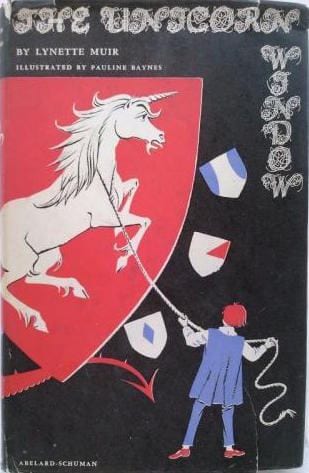 In very Narnian fashion, two children, Anne and Patrick, go to spend the holidays with a professor who lives in an old house in the country, where they stumble into a magical medieval land. (The impression of Narnia is heightened by the drawings by Pauline Baynes.)
In very Narnian fashion, two children, Anne and Patrick, go to spend the holidays with a professor who lives in an old house in the country, where they stumble into a magical medieval land. (The impression of Narnia is heightened by the drawings by Pauline Baynes.)
The premise is that the children break a stained glass window depicting the family crest, allowing the unicorn to escape; to bring it back they must enter the realm of Armorie. This is a kingdom much like medieval Europe, except that it exists in the flattened and symbolically conventionalized world of coats of arms. In its outer Verge particularly, there are no shadows, flowers are all the same shape and size, the sun is a perfect circle surrounded by rays and has certain fixed positions in the sky.
The children are taken to the Castle of Arms, whose denizens all have roles corresponding to aspects of heraldry. Anne is taken charge of by the ladies and does lady things, and Patrick bunks down more roughly with some of the pages and has boy adventures. An expedition is mounted to find the unicorn in the Outer Ring beyond the forest of Family Trees. Patrick participates in a boar hunt, and Anne plays the part of the maiden who can tame the unicorn. After a great festival of celebration, the children return home to find the window restored.
It is a terrific premise, bearing echos of Through the Looking Glass with its fantasy land based on a chess board, as well as The Dog in the Tapestry Garden (1942, Dorothy Lathrop) in which a greyhound enters a medieval tapestry, and the device of passing through a stained glass window in The Amazing Vacation (1956, Dan Wickenden).
Unfortunately, the story itself is dull. Muir was a scholar of medieval studies at the University of Leeds, and The Unicorn Window was her first and one of her few forays into children’s fiction. The adventurous bits are all very derivative from earlier books, and in between the adventures there is a great deal of telling about heraldry and how the realm of Armorie functions.
Nevertheless, I like it that this book exists.
